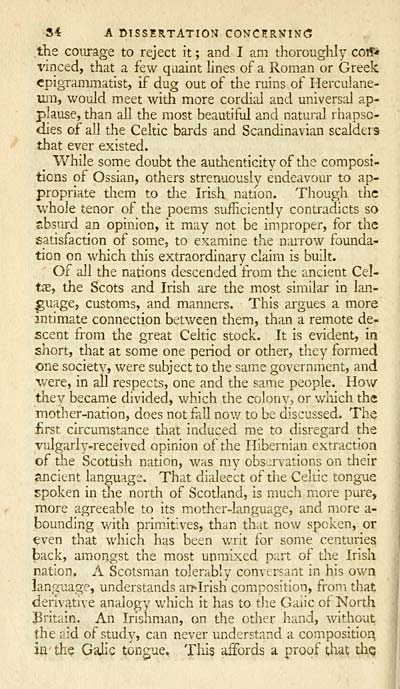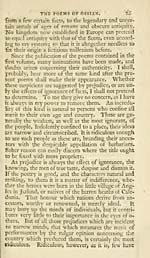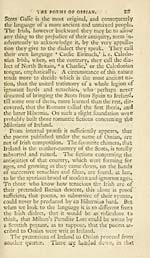Download files
Complete book:
Individual page:
Thumbnail gallery: Grid view | List view

34 A DISSERTATION CO>fCERNINC!
the courage to reject it ; and I am thoroughly coif*
%'inced, that a few quaint hnes of a Roman or Greek
epigrammatist, if dug out of the ruins of Herculane-
um, would meet with more cordial and universal ap-
plause, than all the most beautiful and natural rhapso-
dies of all the Celtic bards and Scandinavian scalders
that ever existed.
While some doubt the authenticity of the composi-
tions of Ossian, others strenuously endeavour to ap-
propriate them to the Irish nation. Though the
whole tenor of the poem.s sufficiently contradicts so
sbsurd an opinion, it may not be improper, for the
satisfaction of some, to examine the narrow founda-
tion on which this extraordinary claim is built.
Of all the nations descended from the ancient Cel-
ts, the Scots and Irish are the most similar in lan-
guage, customs, and manners. This argues a more
intimate connection between them, than a remote de-
scent from the great Celtic stock. It is evident, in
short, that at some one period or other, they formed
one society, were subject to the same government, and
\vere, in all respects, one and the same people. How
they became divided, which the colony, or which the
mother-nation, does not fall now to be discussed. Th$
first circumstance that induced me to disregard the
vulgarly-received opinion of the Hibernian extraction
of the Scottish nation, was my observations on their
ancient language. That dialeect of the Celtic tongue
spoken in the north of Scotland, is much more pure,
more agreeable to its mother-language, and more a-
boundlng with primitives, than that now spoken, or
^ven that which has been writ for some centuries
back, amongst the most unmixed part of die Irish
nation, A Scotsman tolerably conversant in his own
language, understands ar>Irish composition, froni that
derivative analogy which it has to tlie Gaiic of North
JBritain. An Irishman, on the other hand, without
the aid of study, can never understand a composition
ill the Gajic tongue. This affords a proof that tliQ
J
the courage to reject it ; and I am thoroughly coif*
%'inced, that a few quaint hnes of a Roman or Greek
epigrammatist, if dug out of the ruins of Herculane-
um, would meet with more cordial and universal ap-
plause, than all the most beautiful and natural rhapso-
dies of all the Celtic bards and Scandinavian scalders
that ever existed.
While some doubt the authenticity of the composi-
tions of Ossian, others strenuously endeavour to ap-
propriate them to the Irish nation. Though the
whole tenor of the poem.s sufficiently contradicts so
sbsurd an opinion, it may not be improper, for the
satisfaction of some, to examine the narrow founda-
tion on which this extraordinary claim is built.
Of all the nations descended from the ancient Cel-
ts, the Scots and Irish are the most similar in lan-
guage, customs, and manners. This argues a more
intimate connection between them, than a remote de-
scent from the great Celtic stock. It is evident, in
short, that at some one period or other, they formed
one society, were subject to the same government, and
\vere, in all respects, one and the same people. How
they became divided, which the colony, or which the
mother-nation, does not fall now to be discussed. Th$
first circumstance that induced me to disregard the
vulgarly-received opinion of the Hibernian extraction
of the Scottish nation, was my observations on their
ancient language. That dialeect of the Celtic tongue
spoken in the north of Scotland, is much more pure,
more agreeable to its mother-language, and more a-
boundlng with primitives, than that now spoken, or
^ven that which has been writ for some centuries
back, amongst the most unmixed part of die Irish
nation, A Scotsman tolerably conversant in his own
language, understands ar>Irish composition, froni that
derivative analogy which it has to tlie Gaiic of North
JBritain. An Irishman, on the other hand, without
the aid of study, can never understand a composition
ill the Gajic tongue. This affords a proof that tliQ
J
Set display mode to: Large image | Transcription
Images and transcriptions on this page, including medium image downloads, may be used under the Creative Commons Attribution 4.0 International Licence unless otherwise stated. ![]()
| Early Gaelic Book Collections > Ossian Collection > Poems of Ossian, the son of Fingal > Volume 1 > (44) |
|---|
| Permanent URL | https://digital.nls.uk/77910282 |
|---|
| Shelfmark | Oss.53 |
|---|---|
| Additional NLS resources: | |
| Attribution and copyright: |
|
| Description | Selected books from the Ossian Collection of 327 volumes, originally assembled by J. Norman Methven of Perth. Different editions and translations of James MacPherson's epic poem 'Ossian', some with a map of the 'Kingdom of Connor'. Also secondary material relating to Ossianic poetry and the Ossian controversy. |
|---|
| Description | Selected items from five 'Special and Named Printed Collections'. Includes books in Gaelic and other Celtic languages, works about the Gaels, their languages, literature, culture and history. |
|---|

